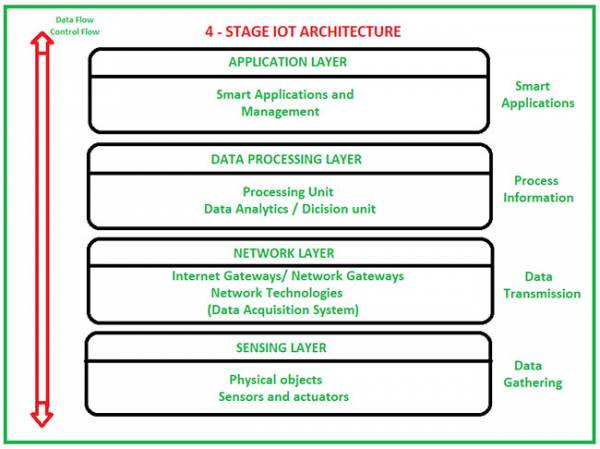What is Internet of Things (IoT)?
What is IoT?
Internet of Things (IoT) is a system of interrelated computing devices, mechanical and digital machines, objects, animals, or people that are provided with unique identifiers and the ability to transfer data over a network without requiring human-to-human or human-to-computer interaction.

In IoT, "Thing" can refer to a person with a heart monitor implant to monitor heart activity, an animal with a biochip (capable of automatic radio signal reception and transmission), a car with built-in sensors to alert the driver of low tire pressure, or any other natural or man-made object assigned an IP address capable of data transmission over a network.
IoT involves the convergence of advanced technologies including wireless communication, micro-electromechanical systems (MEMS), microservices (a software architecture style breaking down software into small, independently deployable services), and the internet. This convergence breaks down the silos between operational technology (OT) and information technology (IT), enabling the analysis of unstructured data to gain insights and improve efficiency.
Kevin Ashton, co-founder and executive director of the Auto-ID Center at MIT, was the first to mention the Internet of Things in a presentation to Procter & Gamble in 1999. Here’s how Ashton explained the potential of IoT back in 1999:
"Today, computers—and, therefore, the Internet—are almost entirely dependent on humans for information. Nearly all of the roughly 50 petabytes (1 petabyte equals 1.024 terabytes) of data available on the Internet were first captured and created by humans typing, pressing record buttons, taking digital pictures, or scanning barcodes.
The problem is that humans have limited time, attention, and accuracy—all of which means they’re not very good at capturing data about things in the real world. If we had computers that knew everything there was to know about things—using data they gathered without any help from us—we could track and count everything, and significantly reduce waste, loss, and costs. We would also know when things needed replacing, repairing, or recalling, and the exact status of them."
The expansion of IPv6 address space is a crucial factor in IoT development. According to Steve Leibson, expanding address space means we can assign IPv6 addresses to every atom on Earth's surface and still have enough left to do it another 100 times. In other words, it becomes feasible to assign an IP address to everything on the planet. The proliferation of smart nodes and the amount of data these nodes are expected to generate will raise various issues related to data security, data ownership, and security.
In reality, applications of IoT technology can be found across many industries, including high-tech agriculture, building management, healthcare, energy, and transportation.
Although the concept of the Internet of Things was coined only in 1999, the technology has been developing for decades. For example, the first internet-connected device was a Coke machine at Carnegie Mellon University in the early 1980s. Programmers could connect to the machine over the internet, check its status, and see if there were cold drinks available. If there were, they would go to get one.
Imagine in an era where the Internet of Things explodes, you can even control every appliance in your home just by gesture, eye contact, or even thought. Self-driving cars, livestock in the barn, and others need not be checked in person but also aware of their health, knowing when they're ready for milk, and even the plant needs water will be self-watering... At that time, we will have more time to care for health, research more advanced issues such as finding routes to other planets.
Internet of Things (IoT) Architecture
The Internet of Things (IoT) technology has many applications, and its use is growing rapidly. Depending on the various application fields of IoT, it operates correspondingly as designed/developed. However, IoT does not have a strictly adhered-to standard working architecture globally. The architecture of IoT depends on its functionalities and deployments in different fields. Nonetheless, there is a basic framework on which IoT is built.

Therefore, in this section, Gpwebmedia.net will discuss the fundamental platform architecture of IoT, namely the 4-stage IoT architecture.
As you can see from the diagram above, the IoT architecture consists of 4 layers: Sensor Layer, Network Layer, Data Processing Layer, and Application Layer.
1. Sensor Layer
This layer consists of sensors, actuators, and devices. Sensors or actuators in this layer receive data (physical/environmental parameters), process it, and transmit it over the network.
2. Network Layer
This layer includes internet gateways/networks and Data Acquisition Systems (DAS). The DAS performs aggregation and data conversion functions (collecting and aggregating data, converting sensor analog data into digital data, etc.). The gateway primarily provides connectivity between the sensor network and the internet, also performing basic functions such as malware protection, filtering decisions based on input data, and data management services.
3. Data Processing Layer
This is the processing unit of the IoT ecosystem. Here, data is analyzed and processed before being sent to the data center, where it is accessed by software applications often referred to as business applications. This is where data is monitored, managed, and actions are prepared.
4. Application Layer
This is the final layer in the 4-stage IoT architecture. The data center or cloud is the management stage where data is managed and utilized by end-user applications such as agriculture, healthcare, aerospace, defense, etc.
This architecture framework provides a structured approach to understanding how IoT systems are organized and function across different domains and applications.
